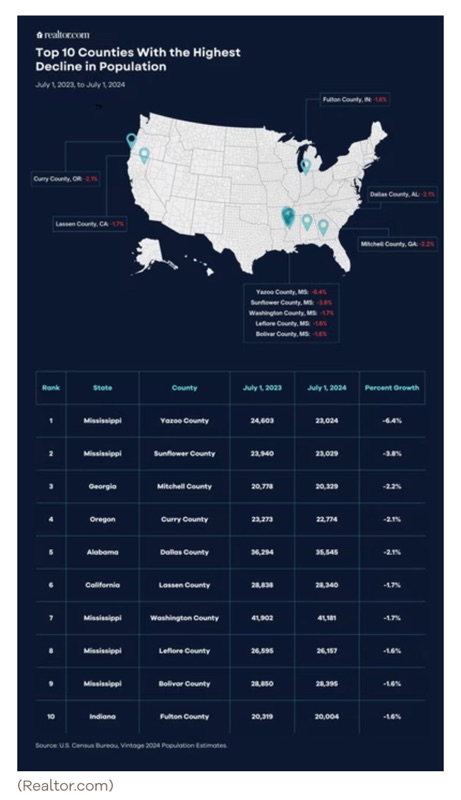Rural America’s Population Problem: Why Residents Are Fleeing—and What It Means for Housing

Rural counties across America are losing residents at an alarming rate—and the ripple effects are reshaping housing markets and local economies in real time.
According to newly released U.S. Census Bureau data, five of the 10 counties with the highest population losses are in Mississippi. Counties like Yazoo and Sunflower, once vital agricultural centers in the Delta, have seen declines of 6.4% and 10.8% respectively. The exodus is driven by a lack of job opportunities and limited economic mobility, particularly for young families.
“Rural communities are fighting uphill battles,” says Daniel Kaufman, President of Kaufman Development. “When the local economy doesn’t support growth, the housing market follows. It’s not just about homes sitting empty—it’s about families making tough decisions to leave generational property behind for better futures elsewhere.”
The data tells a broader story. Across Georgia, Alabama, and Oregon, small counties with populations over 20,000 are struggling to retain residents. Mitchell County, GA, for example, saw a 2.2% population drop despite affordable home prices. Simultaneously, nearly 50% of adults in Mississippi and 45% in Alabama report difficulty meeting basic expenses.
Rising unemployment—up to 5.6% in some counties—only adds fuel to the fire. And while some residents are heading for more economically vibrant nearby areas like Madison County, MS (home to growing operations from Amazon Web Services), others are leaving their home states altogether for urban hubs like Jackson, Memphis, and Mobile.
Still, there are signs of hope. Immigration is helping soften the blow, offsetting what would otherwise be an even steeper decline. In 822 counties, incoming immigrant populations helped stabilize headcounts, per the Population Reference Bureau.
The impact on housing markets is stark. In Yazoo County, the median home lists at $171,156 and sits on the market for 124 days. Sunflower homes list slightly lower but still linger unsold for weeks. Meanwhile, fast-growing counties like Dawson County, GA ($605,794 median list price) and Kaufman County, TX ($352,500) are seeing faster sales and stronger price growth.
As demand shifts toward metro areas, rural communities are left with falling property values, aging housing stock, and less incentive for investment. But there is a path forward.
Experts point to infrastructure investment—particularly broadband access—as a potential game changer. The USDA emphasizes the role of reliable internet in enabling remote work and attracting new businesses. John J. Green, director of the Southern Rural Development Center, notes that regional collaboration and local development efforts are now essential: “For rural communities, this necessitates multicommunity and regional collaboration.”
The stakes are high. Without intentional investment, rural counties may continue to shrink—taking with them the history, heritage, and potential that once made them vital.
About Daniel Kaufman
Daniel Kaufman is a real estate developer and strategist focused on reshaping housing and urban development for a modern America. As President of Kaufman Development and a founder of Oldivai, Daniel leads innovative residential and mixed-use projects across the country. His work emphasizes sustainability, regional collaboration, and economic resilience. Learn more at www.danielkaufman.info.
Comments
Post a Comment